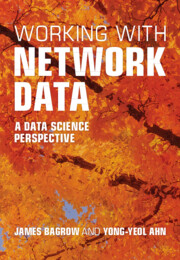Book contents
- Frontmatter
- Contents
- Preface
- Part I Background
- Part II Applications, tools, and tasks
- Chapter 5 The life cycle of a network study
- Chapter 6 Gathering data
- Chapter 7 Extracting networks from data — the “upstream task”
- Chapter 8 Implementation: storing and manipulating network data
- Chapter 9 Incorporating node and edge attributes
- Chapter 10 Awful errors and how to amend them
- Chapter 11 Explore and explain: statistics for network data
- Chapter 12 Understanding network structure and organization
- Chapter 13 Visualizing networks
- Chapter 14 Summarizing and comparing networks
- Chapter 15 Dynamics and dynamic networks
- Chapter 16 Machine learning
- Interlude — Good practices for scientific computing
- Part III Fundamentals
- Conclusion
- Bibliography
- Index
Chapter 8 - Implementation: storing and manipulating network data
from Part II - Applications, tools, and tasks
Published online by Cambridge University Press: aN Invalid Date NaN
- Frontmatter
- Contents
- Preface
- Part I Background
- Part II Applications, tools, and tasks
- Chapter 5 The life cycle of a network study
- Chapter 6 Gathering data
- Chapter 7 Extracting networks from data — the “upstream task”
- Chapter 8 Implementation: storing and manipulating network data
- Chapter 9 Incorporating node and edge attributes
- Chapter 10 Awful errors and how to amend them
- Chapter 11 Explore and explain: statistics for network data
- Chapter 12 Understanding network structure and organization
- Chapter 13 Visualizing networks
- Chapter 14 Summarizing and comparing networks
- Chapter 15 Dynamics and dynamic networks
- Chapter 16 Machine learning
- Interlude — Good practices for scientific computing
- Part III Fundamentals
- Conclusion
- Bibliography
- Index
Summary
In this chapter, we discuss how to represent network data inside a computer, with some examples of computational tasks and the data structures that enable those computations. When working with network data using code, you have many choices of data structures---but which ones are best for our given goals? Writing your own code to process network data can be valuable, yet existing libraries, which feature extensively-tested and efficiently-engineered functionalities, are worth considering as well. Python and R, both excellent programming languages for data science, come well-equipped with third-party libraries for working with network data, and we describe some examples. We also discuss choosing and using typical file formats for storing network data, as many standard formats exist.
Keywords
- Type
- Chapter
- Information
- Working with Network DataA Data Science Perspective, pp. 89 - 104Publisher: Cambridge University PressPrint publication year: 2024



